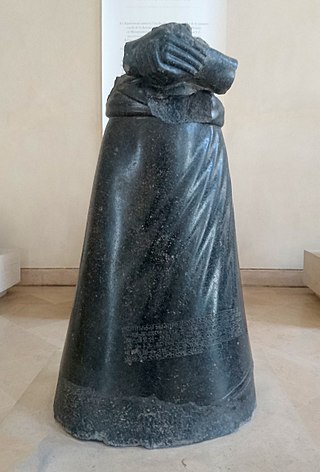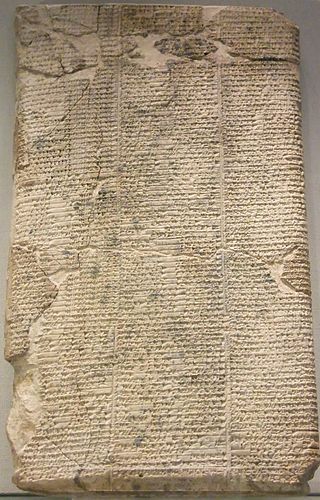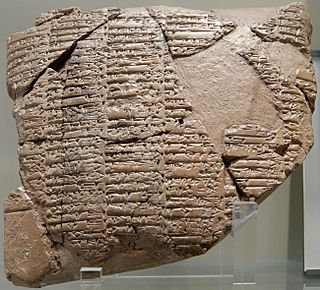
Susa was an ancient city in the lower Zagros Mountains about 250 km (160 mi) east of the Tigris, between the Karkheh and Dez Rivers in Iran. One of the most important cities of the Ancient Near East, Susa served as the capital of Elam and the winter capital of the Achaemenid Empire, and remained a strategic centre during the Parthian and Sasanian periods.

Elam was an ancient civilization centered in the far west and southwest of modern-day Iran, stretching from the lowlands of what is now Khuzestan and Ilam Province as well as a small part of southern Iraq. The modern name Elam stems from the Sumerian transliteration elam(a), along with the later Akkadian elamtu, and the Elamite haltamti. Elamite states were among the leading political forces of the Ancient Near East. In classical literature, Elam was also known as Susiana, a name derived from its capital Susa.

Manishtushu (Man-ištušu) c. 2270-2255 BC was the third king of the Akkadian Empire, reigning 15 years from c. 2270 BC until his death in c. 2255 BC. His name means "Who is with him?". He was the son of Sargon the Great, the founder of the Akkadian Empire, and he was succeeded by his son, Naram-Sin who also deified him posthumously. A cylinder seal, of unknown provenance, clearly from the reign of Naram-Sin or later, refers to the deified Manishtushu i.e. "(For) the divine Man-istusu: Taribu, the wife of Lugal-ezen, had fashioned". Texts from the later Ur III period show offerings to the deified Manishtushu. The same texts mention a town of ᵈMa-an-iš-ti₂-su where there was a temple of Manishtushu. This temple was known in the Sargonic period as Ma-an-iš-t[i-s]uki.
Ruhurater or Lahuratil was an Elamite deity.

Pinikir, also known as Pinigir, Pirengir, Pirinkir, and Parakaras, was an Ancient Near Eastern astral goddess who originates in Elamite religious beliefs. While she is only infrequently attested in Elamite documents, she achieved a degree of prominence in Hurrian religion. Due to her presence in pantheons of many parts of the Ancient Near East, from Anatolia to Iran, modern researchers refer to her as a "cosmopolitan deity."

Inshushinak was the tutelary god of the city of Susa in Elam. His name has a Sumerian etymology, and can be translated as "lord of Susa". He was associated with kingship, and as a result appears in the names and epithets of multiple Elamite rulers. In Susa he was the main god of the local pantheon, though his status in other parts of Elam might have been different. He was also connected with justice and the underworld. His iconography is uncertain, though it is possible snakes were his symbolic animals. Two Mesopotamian deities incorporated into Elamite tradition, Lagamal and Ishmekarab, were regarded as his assistants. He was chiefly worshiped in Susa, where multiple temples dedicated to him existed. Attestations from other Elamite cities are less common. He is also attested in Mesopotamian sources, where he could be recognized as an underworld deity or as an equivalent of Ninurta. He plays a role in the so-called Susa Funerary Texts, which despite being found in Susa were written in Akkadian and might contain instructions for the dead arriving in the underworld.

Puzur-Inshushinak, also sometimes thought to read Kutik-Inshushinak in Elamite, was king of Elam, around 2100 BC, and the last from the Awan dynasty according to the Susa kinglist. He mentions his father's name as Šimpi-išhuk, which, being an Elamite name, suggests that Puzur-Inshuhinak himself was Elamite.

The Awan dynasty was the first dynasty of Elam of which very little of anything is known today—appearing at the dawn of recorded history. The dynasty corresponds to the early part of the first Paleo-Elamite period ; additionally, succeeded by the Shimashki and Sukkalmah dynasties. The Elamites were likely major rivals of neighboring Sumer from remotest antiquity—they were said to have been defeated by Enmebaragesi of Kish c. 2750 BC—who is the earliest archaeologically attested king named on the Sumerian King List (SKL); moreover, by a later monarch, Eannatum of Lagash c. 2450 BC. Awan was a city-state or possibly a region of Elam whose precise location is not certain; but, it has been variously conjectured conjectured to have been within the: Ilam and/or Fars provinces of what is today known as the Islamic Republic of Iran, to the north of Susa, close to Dezful, or Godin Tepe.

Shutruk-Nakhunte was king of Elam from about 1184 to 1155 BC, and the second king of the Shutrukid Dynasty.

The Shimashki dynasty was an early dynasty of the ancient region of Elam, to the southeast of Babylonia,. A list of twelve kings of Shimashki is found in the Elamite king-list of Susa, which also contains a list of kings of Awan dynasty. It is uncertain how historically accurate the list is, although some of its kings can be corroborated by their appearance in the records of neighboring peoples. The dynasty corresponds to the second Paleo-Elamite period. It was followed by the Sukkalmah dynasty. Shimashki was likely near today's Masjed Soleyman.

The Sukkalmah or Epartid dynasty, was an early dynasty of West Asia in the ancient region of Elam, to the southeast of Babylonia. It corresponds to the third Paleo-Elamite period. The Sukkalmah dynasty followed the Shimashki dynasty. The title of Sukkalmah means "Grand Regent" and was used by some Elamite rulers. Numerous cuneiform documents and inscriptions remain from this period, particularly from the area of Susa, making the Sukkalmah period one of the best documented in Elamite history.

Kindattu was the 6th king of the Shimashki Dynasty, in Elam, at the time of the third dynasty of Ur in ancient Lower Mesopotamia.

Khita, sometimes Hita in Elamite, was governor of Susa and the 11th king of the Awan Dynasty of Elam, around 2280 BC. He was most likely the grandfather of the famous Elamite ruler Kutik-Inshushinak, who succeeded him on the throne.
Awan was an ancient city-state or region of Elam in the western area of modern-day Iran. It often appears together with the cities of Susa and Anshan in the early history of Mesopotamia, having many conflictual interactions with Sumer.
Simut or Šimut (Shimut) was an Elamite god. He was regarded as the herald of the gods, and was associated with the planet Mars. He was closely associated with Manzat, a goddess representing the rainbow. He appears in inscriptions of various Elamite kings which mention a number of temples dedicated to him. However, it is not known which city served as his main cult center. He was also worshiped in Mesopotamia, where he was compared with the war god Nergal.
Lagamal or Lagamar was a Mesopotamian deity associated chiefly with Dilbat. A female form of Lagamal was worshiped in Terqa on the Euphrates in Upper Mesopotamia. The male Lagamal was also at some point introduced to the pantheon of Susa in Elam.

The Shutrukid dynasty was a dynasty of the Elamite empire, in modern Iran. Under the Shutrukids, Elam reached a height in power.
Ishmekarab (Išmekarab) or Ishnikarab (Išnikarab) was a Mesopotamian deity of justice. The name is commonly translated from Akkadian as "he heard the prayer," but Ishmekarab's gender is uncertain and opinions of researchers on whether the deity was male or female vary.

Hutelutush-Inshushinak, son of Shilhak-Inshushinak I, was an Elamite king belonging to the Shutrukid dynasty, ruling c. 1120-1100 BC. During the reign of Hutelutush-Inshushinak, Elam was heavily raided by king Nabu-kudurri-usur I of Babylon's Second Dynasty of Isin.












